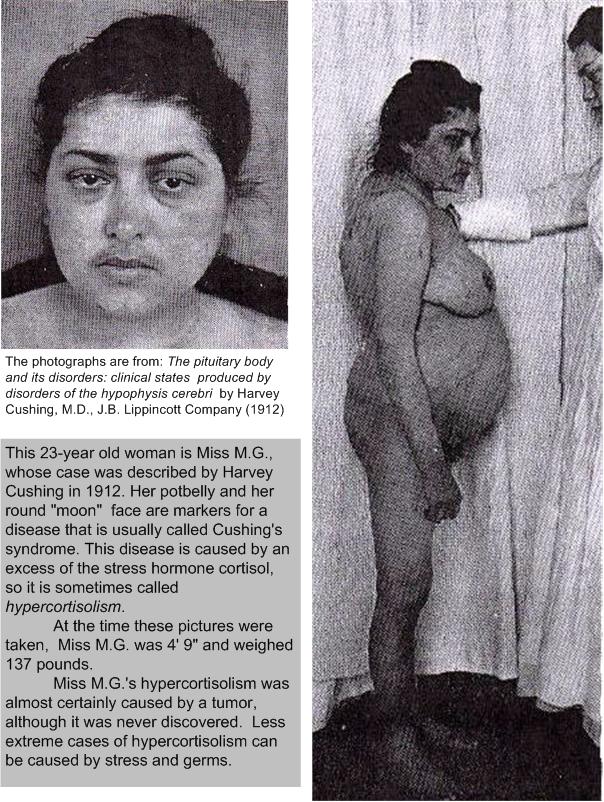Have you seen someone with a 'potbelly' and round moon face?
 | ||
| Photo credits to: potbellysyndrome
Above picture shows a person diagnosed with Cushing's Syndrome which is one of the endocrine system diseases. This is due to hypercortisolism which is caused by the overproduction of cortisol over a period of time. Cortisol is a hormone secreted by one of the endocrine glands.
Nervous system is known as regulatory system that transmits information through electrical impulses. This system works together with the endocrine system which has ductless glands that release hormones.
Photo credits to: Junquiera
Hormones, released by endocrine glands into the blood stream, are chemical messengers that facilitate cell signalling in our body. They act upon all organs by interacting with specific receptors on cell. Hormones have structural specificity and their physiologic activity will be affected if there's an alteration in their molecular composition. They bring about their specific action to their target tissues and this is mediated by receptor molecules. The receptors must be able to identify the hormone among other substances and transmit the binding information into postreceptor events.
Photo credits: Danton, Human Cell Biology
Hormones can reach their target tissues not only through the circulation but can also act locally in the region in which they are released. The action is considered paracrine if the hormones act locally on cells other than those that produced them. E.g. sex steroids in the ovary. Autocrine action, on the other hand, is acting on the cell in which it is produced; the hormone may be released by the cell and then act on it. An example is the insulin released by the pancreatic islet B cells can inhibit insulin release by the same cell.
(1) Releasing hormones
(2) Inhibitory hormones
(3) Tropic hormones
(4) Effector hormones
Hypothalamus secretes selective hormones that release or inhibit secretion of specific Anterior Pituitary hormones.
Hypothalamic Hormones
Source: Clinical Chemistry, Theory, Analysis & Correlations 2nd Edition by Kaplan and Pesces
Two distinct parts: Anterior lobe or Adenohypophysis and Posterior lobe or Neurohypophysis.
-secretes tropic hormones (Thyroid Stimulating Hormone, Adenocorticotropin Hormone, Follicle Stimulating Hormone, Luteinizing Hormone) and two effector hormone (Growth hormone & Prolactin)
Source: Clinical Chemistry, Theory, Analysis & Correlations 2nd Edition by Kaplan and Pesces
*Growth Hormone (GH, Somatotropin)- promote skeletal growth and protein synthesis in young mammals
Pathologic conditions(High levels of ACTH):
*Thyroid Stimulating Hormone (TSH)
*Gonadotropins (Follicle Stimulating Hormone, Luteinizing Hormone)
*Prolactin
Reference range:
Posterior pituitary stores and secretes Anti-diuretic hormones and oxytocin.
Source: Clinical Chemistry, Theory, Analysis & Correlations 2nd Edition by Kaplan and Pesces
*Anti-diuretic Hormone
*Oxytocin
Thyroid Hormones
Source: Clinical Chemistry, Theory, Analysis & Correlations 2nd Edition by Kaplan and Pesces
T3 (3,5,3'-triiodothyronine)-more potent, active
T4 / thyroxine ( 3,5,3',5-tetraiodothyronine)-principal iodinated hormone
TBG (Thyroxine-binding proteins) -transports 70%-75% T3 & T4 (excess 25-30% - albumin & pre-albumin)
Parathyroid Hormones
Source: Clinical Chemistry, Theory, Analysis & Correlations 2nd Edition by Kaplan and Pesces
ADRENOCORTICAL HORMONES
Adrenal gland composed of an outer cortex and an inner core of medulla.
Adrenal Cortex- produces many steroid hormones derived from cholesterol
Source: Clinical Chemistry, Theory, Analysis & Correlations 2nd Edition by Kaplan and Pesces
Cortisol-principal glucocorticoid
Transported in the plasma by:
CUSHING'S SYNDROME-hypersecretion of Cortisol
causes: adrenal hyperplasia, carcinoma, pituitary adenoma, ectopic carcinoma
*Dexamethasone Suppression Test- low plasma cortisol and increase secretion of free cortisol in urine
ADDISON'S DISEASE-low plasma cortisol concentration
causes: destruction of cortical tissue by autoimmune disease/infection, ACTH deficiency
*Administration of exogenous ACTH (rapid ACTH Stimulation Test)- subnormal cortisol response
Adrenal Medulla- releases Epinephrine and Norepinephrine hormones
Source: Clinical Chemistry, Theory, Analysis & Correlations 2nd Edition by Kaplan and Pesces
Pancreas release insulin and glucagon which help in the regulation of serum glucose.
Source: Clinical Chemistry, Theory, Analysis & Correlations 2nd Edition by Kaplan and Pesces
Testes are the male gonads. These secrete the male hormone testosterone and to produce spermatozoa, which are essential for fertilization of the ovum in the reproductive process.
Source: Clinical Chemistry, Theory, Analysis & Correlations 2nd Edition by Kaplan and Pesces
The female gonad, or ovary, has a double function: it produces the female sex hormones and a site of production and maturation of the ova.
Source: Clinical Chemistry, Theory, Analysis & Correlations 2nd Edition by Kaplan and Pesces
regulate the entire digestive process, from the secretion of the gastrointestinal juices to the absorption of the final products of digestion.
Source: Clinical Chemistry, Theory, Analysis & Correlations 2nd Edition by Kaplan and Pesces
Pineal gland secretes two neurotransmitters, erotonin and melanin, that modulate some circadian rythms of the endocrine system.
Source: Clinical Chemistry, Theory, Analysis & Correlations 2nd Edition by Kaplan and Pesces
Let's try to trigger those neurons and release some hormones! :)
Try to identify the parts of the endocrine system and enumerate some of the hormones being secreted. Don't cheat, test yourself.
Photo credits: Junquiera
Domo arigato!
References:
Greenspan, F.,
Baxter, J., Basic Clinical Endocrinology, 4th edition
Kaplan, L.,
Pesce, A., Clinical Chemistry: Theory, Analysis and Correlation, 2nd
edition
Kaplan, A.,
Toivola, B., Ophain, K., Lyon, A., Jack, R., Clinical Chemistry: Interpretation
and Techniques, 4th edition
|



























0 comments:
Post a Comment